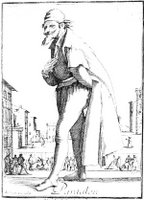Commedia del'arte

Commedia dell'arte (Italian: "comedy of professional artists" also interpreted as "comedy of humors"), also known as Extemporal Comedy, was a form of improvisational theater which began in the 16th century and was popular until the 18th century, although it is still performed today.
The characters or "masks," in spite of changes over the years, retained much of their original flavor. Most important were the zanni, or servant types; Arlecchino, or Harlequin, was the most famous. He was an acrobat and a wit, childlike and amorous. He wore a catlike mask and motley colored clothes and carried a bat or wooden sword, the ancestor of the slapstick. His crony, Brighella, was more roguish and sophisticated, a cowardly villain who would do anything for money. Figaro and Molière's Scapin are descendants of this type. Pedrolino was a white-faced, moon-struck dreamer; the French Pierrot Pierrot .Pagliaccio, the forerunner of today's clown, was cl
 osely akin to Pedrolino.
osely akin to Pedrolino.Pulcinella, as seen in the English Punch and Judy Punch and Judy shows, was a dwarfish humpback with a crooked nose, the cruel bachelor who chased pretty girls. Pantalone or Pantaloon was a caricature of the Venetian merchant, rich and retired, mean and miserly, with a young wife or
 an adventurous daughter. Il Dottore (the doctor), his only friend, was a caricature of learning—pompous and fraudulent; he survives in the works of Molière. Il Capitano (the captain) was a caricature of the professional soldier—bold, swaggering, and cowardly. He was replaced by the more agile Scarramuccia or Scaramouche, who, dressed in black and carrying a pointed sword, was the Robin Hood of his day.
an adventurous daughter. Il Dottore (the doctor), his only friend, was a caricature of learning—pompous and fraudulent; he survives in the works of Molière. Il Capitano (the captain) was a caricature of the professional soldier—bold, swaggering, and cowardly. He was replaced by the more agile Scarramuccia or Scaramouche, who, dressed in black and carrying a pointed sword, was the Robin Hood of his day.The handsome Inamorato (the lover) went by many names. He wore no mask and had to be eloquent in order to speak the love declamations. The Inamorata was his female counterpart; Isabella Andreini Andreini, Isabella Canali , was the most famous. Her servant, usually called Columbine, was the beloved of Harlequin. Witty, bright, and given to intrigue, she developed into such characters as Harlequine and Pierrette. La Ruffiana was an old woman, either the mother or a village gossip, who thwarted the lovers. Cantarina and Ballerina often took part in the comedy, but for the most part their job was to sing, dance, or play music. None of the women wore masks.


0 Comments:
Post a Comment
<< Home